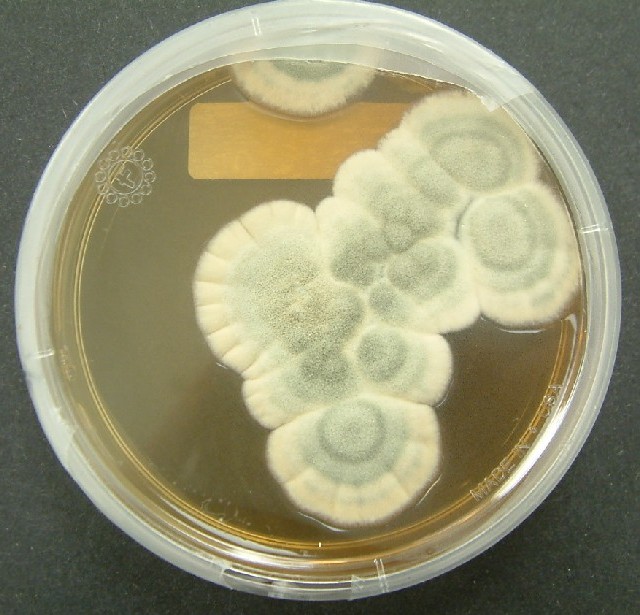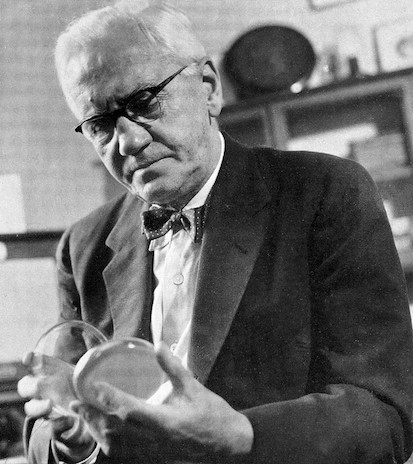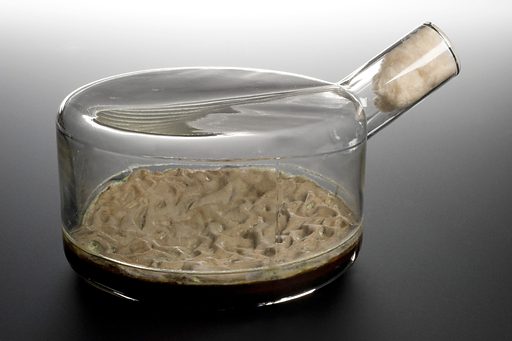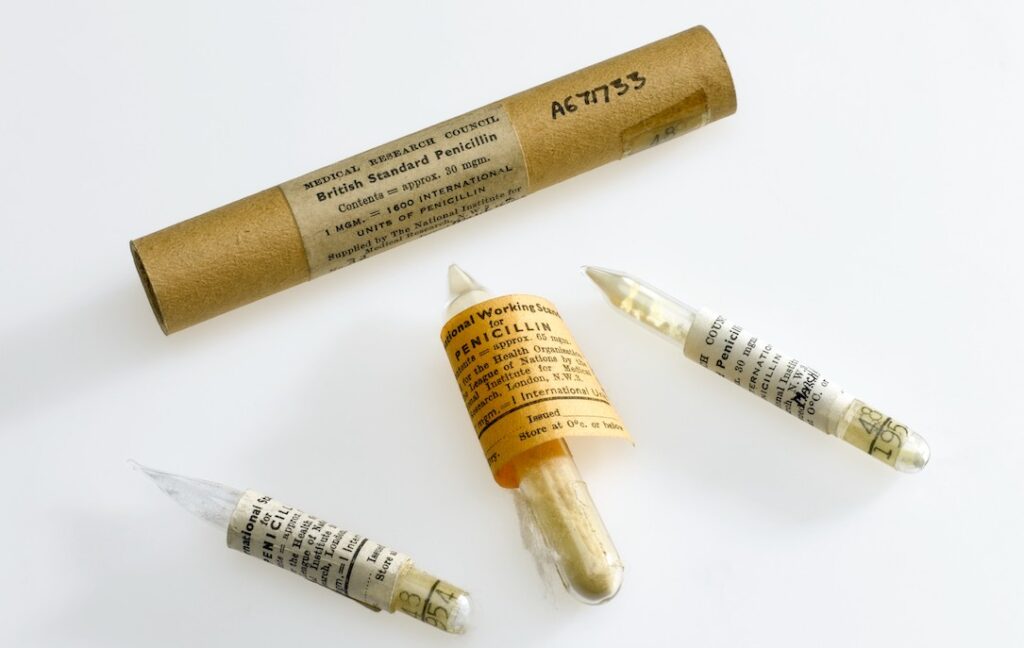The discovery of penicillin remains a true turning point; not just for medical history, but for human history in general. As one of the world’s first antibiotics, it meant that doctors at last had a tool to cure their patients of infectious diseases that had once been a death sentence. Penicillin is derived from a mold called Penicillium notatum, and as antithetical to the sterile medical environments we imagine it may seem, mold has long been used in medical research.
The Fungi Family
Mold is part of the fungi family, and is a cousin of delicious culinary mushrooms, as well as mind-bending trippy mushrooms. Though, unlike them, mold is far less appealing. So how did something synonymous with death and decay actually end up saving innumerable lives? Well, rather like Albert Hofmann’s discovery of LSD (derived from the ergot fungus) it was something of an accident…
Dr. Fleming Returns to a Mess…

Picture the scene; it’s 1928 and bacteriologist Dr. Alexander Fleming has just returned to London from his summer holiday in Scotland. His lab at St. Mary’s Hospital has been left in rather a mess, and he notices that his colonies of Staphylococcus aureus (a type of bacteria, natch) have been contaminated by mold. Kind of like when you accidentally leave a mug of half drunk tea somewhere and find an entire ecosystem growing there happily a week later. This mold was called Penicillium notatum, and instead of shouting ‘yuck!’ and emptying his petri dishes, Fleming acted like the bacteriologist he was, and decided to have a gander at them under his microscope.
Observing the interaction between the bacteria and the mold, Fleming was amazed to find that the Penicillium notatum had prevented the normal growth of the Staphylococcus aureus. To confirm his findings, Fleming had to wait for more of the mold to grow (which is probably only marginally better than watching paint dry!) But once it did, Fleming could confirm his incredible discovery — that the Penicillium mold had the ability to inhibit the growth of bacteria. This meant that it could potentially be harnessed to fight infectious diseases.
“I Didn’t Plan to Revolutionize Medicine”
Dr. Fleming later wrote about that fateful day;
“When I woke up just after dawn on September 28, 1928, I certainly didn’t plan to revolutionize all medicine by discovering the world’s first antibiotic, or bacteria killer. But I guess that was exactly what I did.”
In this case, you can’t really blame Dr. Fleming for tooting his own horn. However, the story doesn’t end there. There would be quite a few steps before the fungi could actually be used medically. And unfortunately, Fleming had neither the chemistry training, nor the facilities at St. Mary’s to do the things that could make it a viable treatment. These ‘things’ were; isolating the active ingredient in the penicillin mold, purifying it, working out what germs it could combat, and how to actually use it. So, despite his discovery, after publishing a paper on it, Fleming’s research petered out. It sure makes you grateful you can just eat psilocybin mushrooms!

The Bacterial Baton is Passed
So this task was, by chance, picked up by Dr. Howard Florey, a professor of pathology at Oxford University. He was skilled at soliciting research grants, and at putting together dream-teams of scientist colleagues. Long interested in the antagonistic relationship between bacteria and mold, in 1938 Dr. Florey was flicking through some old editions of The British Journal of Experimental Pathology, when he happened upon Fleming’s paper on penicillium mold’s bacteria killing properties. Soon, he had assembled his lab-colleagues, and they were ready to unravel what Fleming meant by penicillium’s “antibacterial action.”
The team, which included gifted biochemist Dr. Ernst Chain, soon produced a series of primitive extracts of the penicillium mold culture. Then, over the summer of 1940 they proceeded to experiment on 50 unfortunate mice, infecting them with deadly streptococcus. Half went on to die from extreme sepsis. But the other half, who had been administered penicillin injections, survived.
A Production Issue
After this clear success, Dr. Florey decided he had enough evidence to test the drug on people. But there was a problem. Over 2,000 liters of mold were needed to make enough of the pure penicillin to treat one person with sepsis. And, unsurprisingly, growing a yield of mold that large was not the easiest or most efficient thing in the world.
A vital figure in this process was Dr. Norman Heatley, a biochemist who made it his mission to grow mold in every vessel available (sounds a bit like my old roommate! 😉) From bottle to bedpan, Heatley grew penicillin mold, suctioned off the fluid, and created ways to purify it. Today, penicillin is produced in enormous fermentation tanks and uses sophisticated extraction techniques. However, this was the humble way that production of the antibiotic began.

Penicillin Crosses the Pond
In 1941, not long before the U.S would enter World War II, Florey and Heatley traveled to the States to work with American scientists in Peoria, Illinois, to develop a way of mass producing their burgeoning ‘wonder drug’.
Realizing that their OG Penicillin notatum would never be able to produce enough penicillin to treat people reliably, the two Doctors looked for a more productive species of mold.
Then, one warm summer day, lab assistant Mary Hunt brought in a cantaloupe melon from the market which was blanketed with a “pretty, golden, mold.” As luck would have it, this gorgeous mold turned out to be the fungus Penicillium chrysogeum. It was found to yield 200x the amount of the originally tested species. But even this species needed enhancing with mutation-inducing X-rays and filtration. Ultimately, however, they were able to produce 1,000 times as much penicillin as their original efforts.
Penicillin Saves Soldiers
Penicillin would prove itself during the war. The major killer in wars, throughout history, had been infection. In the pre-penicillin WWI 18% of those with bacterial pneumonia died. In WWII it fell to less than 1%.
By the end of the war American pharmaceutical companies were producing 650 billion units of penicillin a month. However, much is the dismay of Dr. Florey and his team of Oxford scientists, news reports on the ‘miracle drug’ focused squarely on Dr. Fleming, and their significant contributions were ignored.
This was somewhat corrected in 1945 when Fleming, Florey and Chain were awarded the Nobel Prize in Physiology or Medicine. Heatley’s contribution was not recognized until 1990 when Oxford University awarded him the first ever honorary doctorate of medicine in their 800 year legacy.
Every September the 28th, the discovery of penicillin, by Dr. Fleming is celebrated. But it is also worth remembering the dedicated group of people who helped to birth it into what it is today.

The Future of Medicinal Mushrooms
Who can say what the future of psilocybin as a global medicine will be? Of course it is very different from penicillin, aiding mental health and chronic pain rather than infection. And, differently again, it can be accessed by anyone. All you need is a shroom grow kit or some magic truffles, making it a very different kettle of fish, indeed.
However, what unites penicillium mold and psilocybin mushrooms is that they are fascinating fungi that somehow are able to care for, and heal, humanity. They are both mysterious and magical. It seems that for medicine, the past, present, and future is….. fungal 😉






